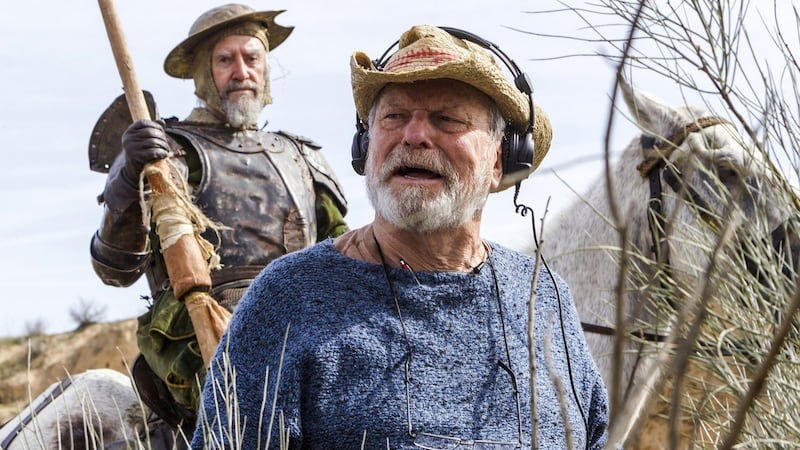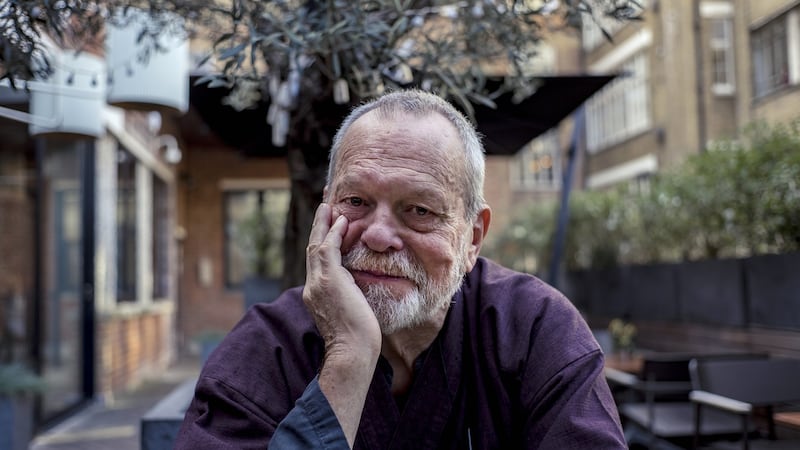“After every film I go through months of postpartum depression,” grins Terry Gilliam. “But I’d get through it and there was always Quixote to go back to. I don’t know what I’m going to do.”
He laughs: “My life is over!”
The history of cinema is littered with counterfactual intrigues. We can only guess as to the merits of Stanley Kubrick’s abandoned Napoleon and Orson Welles’ unfinished Moby Dick.
But one doomed project has caught the public imagination more than any other: Terry Gilliam’s ill-fated Don Quixote, a film that contributed toward a perforated medullary artery in spring of 2018 and might have killed him.
According to some news outlets: it did. Variety’s pre-prepared obituary, titled “Monty Python’s Terry Gilliam, director of Brazil, dies at XXX” was accidentally published in September 2015.
“I have a lawyer who has a good sense of humour,” says Gilliam. “I called and I said: this could be fun. So I wrote a letter to the editors and I explained that I was on a plane flying from Italy and that my wife and the kids were in France. I embellished a bit and asked if, for the pain and anguish that you caused my family, it would be so nice if you could send me a case of Château Margaux? They sent me two.”
The one-time Python and filmmaker began tilting at Miguel de Cervantes’ The Ingenious Nobleman Sir Quixote of La Mancha as long ago as 1989 when Gilliam and his Brazil co-writer Charles McKeown began work on a script.
By 1990, Sean Connery and Danny DeVito were rumoured for Quixote and Sancho Panza respectively, until the $25 million budget fell through. The director took a second stab at adapting the unwieldy 17th century novel with co-writer Tony Grisoni, before he signed on for the similarly-themed The Fisher King in 1991. Years passed. Gilliam scored a second Hollywood hit with 12 Monkeys and made a splash at Cannes with Fear and Loathing in Las Vegas in 1998.
We say splash.
“I remember standing with Johnny [Depp] and Benicio [Del Toro] waiting to go talk to the press,” says Gilliam. “The press screening was in the morning. And the PR person comes in and he’s ashen-faced. I said: what’s wrong? And he says: They hate it! They’ve torn it apart! And we had to do interviews with those people knowing that. It took a couple of days for some journalists to to go against the grain and say: Oh, I liked it. They were whispering. The peer pressure at Cannes is ridiculous.”
Depp would reunite with Gilliam for The Man Who Killed Don Quixote, co-starring Jean Rochefort as Quixote and Vanessa Paradis as the female lead. Shooting began in 2000 in Navarre with a budget of $32 million, making it (potentially) the highest budgeted European financed film of that time.
Flash floods and jets
Depp was to play Toby, an advertising executive, who, with a nod to Mark Twain’s Connecticut Yankee in King Arthur’s Court, travels through time to meet Quixote, only for the knight to mistake him for Sancho Panza. But seven weeks before production, Gilliam was having trouble tracking the actor down. Four weeks out from the shoot and Vanessa Paradis had yet to sign on the dotted line.
As the clock ticked down, Jean Rochefort cancelled a flight to Spain citing prostate infection. The French veteran’s ailments worsened on set with a double hernia and slipped disc.
Finally, God, the popular Old Testament tyrant intervened, with flash floods and mudslides that swept away the camera equipment. Nato piled on further misery by flying jets that ruined the soundtrack. And the insurance disappeared as various impediments were adjudged to fall under the heading “Act of God”.
An undeterred Gilliam beat on, with new cast members Robert Duvall and Ewan McGregor. But filming was abandoned when the locations were devastated by storms. Between 2003 and 2016, various attempts featuring such various actors as Colin Farrell, Michael Palin, Jack O’Connell and John Hurt, all floundered.
It was, says Gilliam, “...the Sisyphean rock that kept rolling back”.

At the Cannes Film Festival in 2016, the director shrugged off the suggestion of a curse as he announced the newest production of The Man Who Killed Don Quixote: “I want to get this film out of my life so that I can get on with the rest of my life,” Gilliam told the assembled press.
In May of 2018, Gilliam returned to the Croisette with The Man Who Killed Don Quixote, which received a 10-minute standing ovation as the closing night screening.
“It was an absurdly long standing ovation,” laughs Gilliam. “I still don’t know what it was about. I’m wondering if they love the film or or is it a testament to my endurance? Maybe they hated the film? What’s going on? And I’m standing there looking like an idiot.”
Even with the film in the can, he almost didn’t get his premiere. A falling out with former producer Paulo Branco led to a protracted legal battle as Branco attempted to sue the director for breach of contract. The producer also unsuccessfully sought an injunction to block the release of the film as well as its screening in Cannes.
“Of the 30 years I’ve been involved in this project, Paulo Branco was involved for four months,” says Gilliam. “If you’re going to have a producer who’s been inspired by Donald Trump, here’s your man. Paolo has done 280 films and they were all for under €2m. This movie cost €60m. It’s a different league. But I believed him when he said that he could solve all of our financial problems. We had two-thirds of the money so he only needed to raise one third. And he raised only half that over four months. He fired everybody because he thought he could do it all himself. And he failed. So on the day that all the actors were in cars coming to Lisbon for our first down read, he pulls the plug and starts lawsuits. By the time we get to Cannes, he’s already tried three lawsuits in a row. But his big moment of hubris comes when he tries to sue the festival. That was a bad thing to do. And then there was another case with the French distributor. He lost them all. So we go to the ball.”
The making of Gilliam’s Don Quixote ought to have its own movie. In fact, it has two. Directors Keith Fulton and Louis Pepe, who began working with Gilliam on The Hamster Factor and Other Tales of Twelve Monkeys, a 1995 making-of film, chronicled the director’s 2000 production in the popular documentary, Lost in La Mancha. An incoming sequel, titled He Dreamed of Giants, picks up where Lost in La Mancha left off. Gilliam is not a fan of the new film.
“The problem was the shooting of the film went really smoothly so they didn’t have a story,” he says. “So the best story they could get was some complications. There are moments when I’m texting and I’m struggling but I’m actually just tired. For the last couple of months of the shoot I had a catheter because of my prostate and they missed the usefulness of it as a director. I could just sit there in my chair smiling filling my little ankle bag. And they overplay that: is the old fart going to die? They’re friends but I don’t like the film.”

We should not be surprised that he’s so frank in his appraisal of his chums’ film. With a comparatively nothingy promotional budget set against the heft of awards season, Gilliam has generated headlines and attention by voicing some off-colour remarks about Harvey Weinstein and Me Too. It has worked, too. When he recently recycled a politically incorrect joke he made at the Karlovy Vary festival in 2018 –“I no longer want to be a white male, I don’t want to be blamed for everything wrong in the world: I tell the world now I’m a black lesbian … My name is Loretta and I’m a BLT, a black lesbian in transition” – it made a big splash in a slow news week.
‘Bomb-making’
Today, as I sit down with him in London, he has plenty to say about, well, everything.
“These people think Boris Johnson is going to deliver Brexit?” he says, gesturing beyond the window. “It’s going to take ages to resolve this whole thing.”
He also “reveals” something about Adam Driver that we won’t be committing to print. “I’ll leave you to do the research on that,” twinkles Gilliam. “You didn’t hear it from me.”
In common with much of the planet, the director is rather taken with Driver. In its finished form, The Man Who Killed Don Quixote features the Marriage Story star as an arrog0ant commercial director named Toby who is trying to make a Quixote-themed ad. When he happens on a La Mancha-themed student film he made years earlier, Toby revisits the town where he made the film, only to discover that the project has had lasting consequences, notably that Jonathan Pryce’s character, Javier – a local cobbler that Toby had cast as Quixote – now believes that he is the windmill-challenging knight.
“In the States we screened the film too late for a lot of the nominations,” says the director. “But I think Adam Driver’s performance is incredible. It shows the range of his talent because when you look at him playing a cynical commercials director and then you see him as a younger man and you put those scenes side by side, it looks like a different guy. And that’s not make-up. That’s coming from inside him. And put that up against Jonathan Pryce and they become one of the great double acts. Adam intrigues me. I asked him if he was Jewish because he has some kind of old wisdom about him. But he says its Native American. He’s so ure. And that’s what impressed me the first day I met him in a pub in Hampstead. Whatever he was putting out, it wasn’t an actor trying to get a job. He comes from the midwest like us all simple people
“And after 9/11, he goes off and he joined the Marines. So he’s either a complete idiot or he’s the last pure-hearted person out there.”
In a 2003 interview with Salman Rushdie, Gilliam suggested that if he had stayed in the US in the 1960s, he might have been “a full-time, bomb-throwing terrorist”. It’s a calling that sounds easier than his film-making career of late.
“I could have had a more black and white life,” he nods. “But I wouldn’t have got to meet all the people I have worked with. I’m actually almost back into the frame of mind of bomb-making because look what’s just happening. It started with Trump and then it’s as if Pandora’s Box opened up. The narcissistic egomaniacal autocrats spring up like mushrooms. What the f*** is going on? Why are the people falling for it?”
The Man Who Killed Don Quixote is released January 31st; there will be a nationwide event screening followed by a Q&A with Terry Gilliam on January 23rd













